Ionizing Spotlight of Active Galactic Nucleus
Abstract
1. Introduction
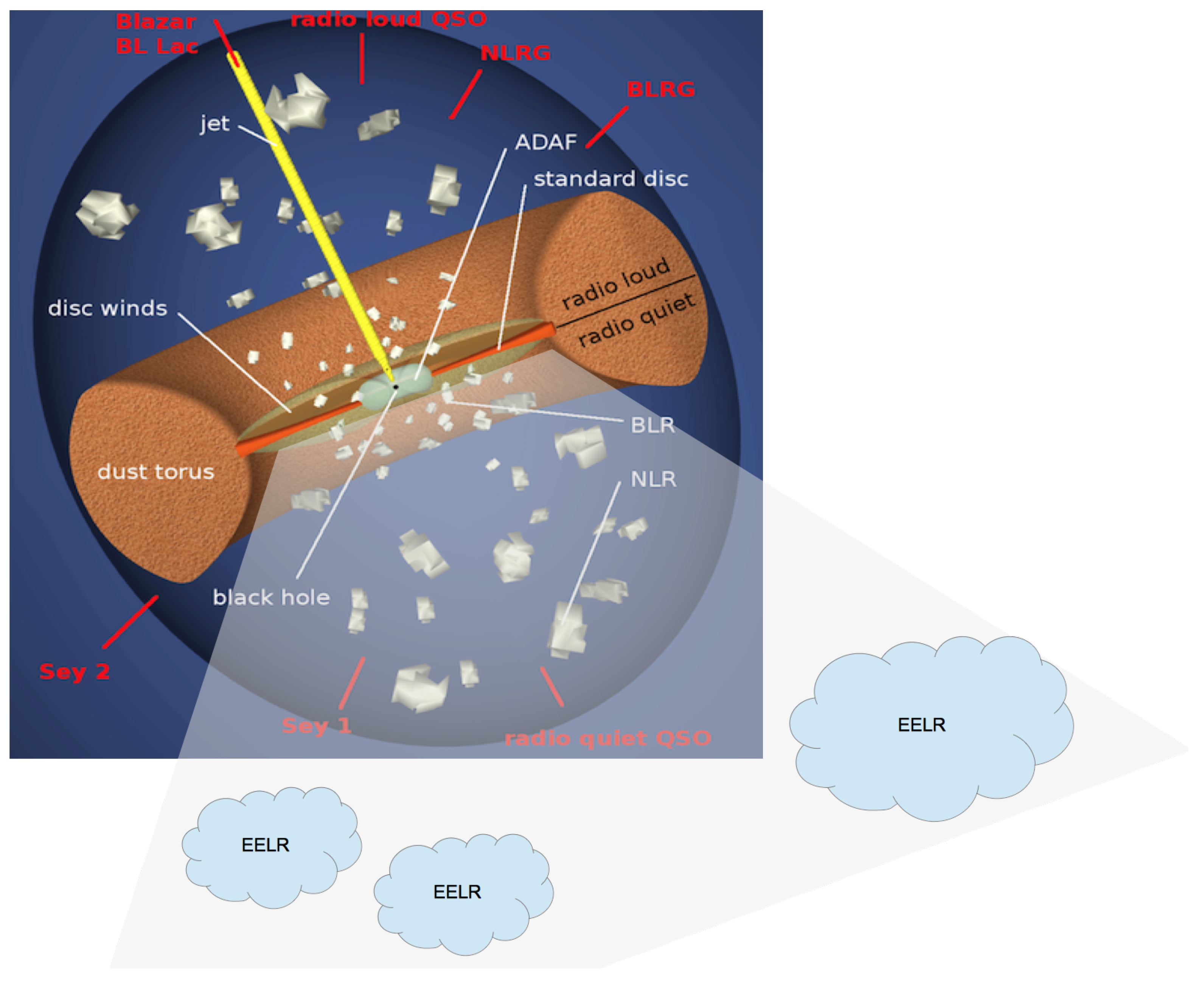
- Study of the gas environment of galaxies (accretion of gas clouds, cosmological filaments, etc.)
- ‘Aracheology of active galactic nuclei’ [13]—a history of supermassive black hole activity at the light-travel time from the AGN to the gas clouds.
- Constrain of the unified model parameters related with the ionization cones: measuring the cone angle, looking for traces of their precession, constraints of absorbing matter distribution models.
2. Filaments of the Intergalactic Medium
2.1. The Nearest Example: Mrk 6
2.2. Cosmological Filaments
3. Galaxies with Fading Activity
3.1. Duty Cycle of AGN
3.2. Hanny’s Voorwerp
3.3. New Examples: ‘Voorwerpjes’
4. EELR Statistical Study
4.1. Surveys of Nearby AGNs
4.2. Cross-Ionization of a Companion
5. Activity of the Milky Way Nucleus
6. Ionization Cones and Nuclear Outflows
7. Conclusions and Future Directions
Author Contributions
Funding
Data Availability Statement
Acknowledgments
Conflicts of Interest
Abbreviations
| AGN | Active galaxy nucleus |
| EELR | Extended Emission-Line Regions |
| FPI | Fabry-Perot interferometer |
| JWST | James Webb Space Telescope |
| HST | Hubble Space Telescope |
| HV | Hanni’s Voorwerp |
| LINER | Low-ionization nuclear emission-line region |
| LOFAR | International Low-Frequency Array |
| MUSE | Multi Unit Spectroscopic Explorer |
| SAI MSU | Sternberg Astronomical Institute of Lomonosov Moscow State University |
| SAO RAS | Special Astrophysical Observatory of the Russian Academy of Sciences |
| SCORPIO | Spectral Camera with Optical Reducer for Photometric and Interferometric Observations |
| SDSS | Sloan Digital Sky Survey |
| Sy | Seyfert galaxy |
References
- Event Horizon Telescope Collaboration; Akiyama, K.; Alberdi, A.; Alef, W.; Asada, K.; Azulay, R.; Baczko, A.K.; Ball, D.; Baloković, M.; Barrett, J.; et al. First M87 Event Horizon Telescope Results. IV. Imaging the Central Supermassive Black Hole. Astrophys. J. Lett. 2019, 875, L4. [Google Scholar] [CrossRef]
- Event Horizon Telescope Collaboration; Akiyama, K.; Alberdi, A.; Alef, W.; Algaba, J.C.; Anantua, R.; Asada, K.; Azulay, R.; Bach, U.; Baczko, A.K.; et al. First Sagittarius A* Event Horizon Telescope Results. I. The Shadow of the Supermassive Black Hole in the Center of the Milky Way. Astrophys. J. Lett. 2022, 930, L12. [Google Scholar] [CrossRef]
- Antonucci, R. Unified models for active galactic nuclei and quasars. ARA&A 1993, 31, 473–521. [Google Scholar] [CrossRef]
- Urry, C.M.; Padovani, P. Unified Schemes for Radio-Loud Active Galactic Nuclei. Publ. Astron. Soc. Pac. 1995, 107, 803. [Google Scholar] [CrossRef]
- Kormendy, J.; Kennicutt, R.C.J. Secular Evolution and the Formation of Pseudobulges in Disk Galaxies. ARA&A 2004, 42, 603–683. [Google Scholar] [CrossRef]
- Silk, J.; Mamon, G.A. The current status of galaxy formation. Res. Astron. Astrophys. 2012, 12, 917–946. [Google Scholar] [CrossRef]
- Kormendy, J.; Ho, L.C. Coevolution (Or Not) of Supermassive Black Holes and Host Galaxies. ARA&A 2013, 51, 511–653. [Google Scholar] [CrossRef]
- Pillepich, A.; Springel, V.; Nelson, D.; Genel, S.; Naiman, J.; Pakmor, R.; Hernquist, L.; Torrey, P.; Vogelsberger, M.; Weinberger, R.; et al. Simulating galaxy formation with the IllustrisTNG model. Mon. Not. R. Astron. Soc. 2018, 473, 4077–4106. [Google Scholar] [CrossRef]
- Brinkmann, S. On the Numerical Simulation of Advection Dominated Accretion Flows. Ph.D. Thesis, Ruprecht-Karls University of Heidelberg, Heidelberg, Germany, 2009. [Google Scholar]
- Wilson, A.S.; Tsvetanov, Z.I. Ionization Cones and Radio Ejecta in Active Galaxies. Astron. J. 1994, 107, 1227. [Google Scholar] [CrossRef]
- Stockton, A.; Fu, H.; Canalizo, G. QSO extended emission-line regions. New Astron. Rev. 2006, 50, 694–700. [Google Scholar] [CrossRef]
- Keel, W.C.; Chojnowski, S.D.; Bennert, V.N.; Schawinski, K.; Lintott, C.J.; Lynn, S.; Pancoast, A.; Harris, C.; Nierenberg, A.M.; Sonnenfeld, A.; et al. The Galaxy Zoo survey for giant AGN-ionized clouds: Past and present black hole accretion events. Mon. Not. R. Astron. Soc. 2012, 420, 878–900. [Google Scholar] [CrossRef]
- Morganti, R. Archaeology of active galaxies across the electromagnetic spectrum. Nat. Astron. 2017, 1, 596–605. [Google Scholar] [CrossRef]
- Capetti, A.; Axon, D.J.; Kukula, M.; Macchetto, F.; Pedlar, A.; Sparks, W.B.; Boksenberg, A. The Emission-Line Jet in Markarian 6*. Astrophys. J. Lett. 1995, 454, L85. [Google Scholar] [CrossRef]
- Afanasiev, V.L.; Popović, L.Č.; Shapovalova, A.I.; Borisov, N.V.; Ilić, D. Variability in spectropolarimetric properties of Sy 1.5 galaxy Mrk 6. Mon. Not. R. Astron. Soc. 2014, 440, 519–529. [Google Scholar] [CrossRef][Green Version]
- Kukula, M.J.; Holloway, A.J.; Pedlar, A.; Meaburn, J.; Lopez, J.A.; Axon, D.J.; Schilizzi, R.T.; Baum, S.A. Unusual radio and optical structures in the Seyfert galaxy Markarian 6. Mon. Not. R. Astron. Soc. 1996, 280, 1283–1292. [Google Scholar] [CrossRef][Green Version]
- Smirnova, A.A.; Moiseev, A.V.; Dodonov, S.N. A close look at the well-known Seyfert galaxy: Extended emission filaments in Mrk 6. Mon. Not. R. Astron. Soc. 2018, 481, 4542–4547. [Google Scholar] [CrossRef]
- Sánchez Almeida, J.; Elmegreen, B.G.; Muñoz-Tuñón, C.; Elmegreen, D.M. Star formation sustained by gas accretion. Astron. Astrophys. Rev. 2014, 22, 71. [Google Scholar] [CrossRef]
- Sil’chenko, O.K. Empirical scenarios of galaxy evolution. Phys. Usp. 2022, 65, 1224–1247. [Google Scholar] [CrossRef]
- Cantalupo, S.; Arrigoni-Battaia, F.; Prochaska, J.X.; Hennawi, J.F.; Madau, P. A cosmic web filament revealed in Lyman-α emission around a luminous high-redshift quasar. Nature 2014, 506, 63–66. [Google Scholar] [CrossRef]
- Sanderson, K.N.; Prescott, M.K.M.; Christensen, L.; Fynbo, J.; Møller, P. Mapping the Morphology and Kinematics of a Lyα-selected Nebula at z = 3.15 with MUSE. Astrophys. J. 2021, 923, 252. [Google Scholar] [CrossRef]
- Wang, W.; Wylezalek, D.; Vernet, J.; De Breuck, C.; Gullberg, B.; Swinbank, M.; Villar Martín, M.; Lehnert, M.; Drouart, G.; Arrigoni Battaia, F.; et al. 3D tomography of the giant Lyα nebulae of z ≈ 3–5 radio-loud AGN. arXiv 2023, arXiv:2309.15144. [Google Scholar] [CrossRef]
- Gebhardt, K.; Bender, R.; Bower, G.; Dressler, A.; Faber, S.M.; Filippenko, A.V.; Green, R.; Grillmair, C.; Ho, L.C.; Kormendy, J.; et al. A Relationship between Nuclear Black Hole Mass and Galaxy Velocity Dispersion. Astrophys. J. Lett. 2000, 539, L13–L16. [Google Scholar] [CrossRef]
- Ferrarese, L.; Merritt, D. A Fundamental Relation between Supermassive Black Holes and Their Host Galaxies. Astrophys. J. Lett. 2000, 539, L9–L12. [Google Scholar] [CrossRef]
- Jogee, S. The Fueling and Evolution of AGN: Internal and External Triggers. In Physics of Active Galactic Nuclei at All Scales; Alloin, D., Ed.; Springer: Berlin/Heidelberg, Germany, 2006; Volume 693, p. 143. [Google Scholar] [CrossRef]
- Combes, F. Fueling the AGN. In Advanced Lectures on the Starburst-AGN; Aretxaga, I., Kunth, D., Mújica, R., Eds.; World Scientific Publishing Company: Singapore, 2001; p. 223. [Google Scholar] [CrossRef]
- Combes, F. Circum-nuclear molecular disks: Role in AGN fueling and feedback. In Galaxy Evolution and Feedback across Different Environments; Storchi Bergmann, T., Forman, W., Overzier, R., Riffel, R., Eds.; Cambridge University Press: Cambridge, UK, 2021; Volume 359, pp. 312–317. [Google Scholar] [CrossRef]
- LaMassa, S.M.; Cales, S.; Moran, E.C.; Myers, A.D.; Richards, G.T.; Eracleous, M.; Heckman, T.M.; Gallo, L.; Urry, C.M. The Discovery of the First “Changing Look” Quasar: New Insights Into the Physics and Phenomenology of Active Galactic Nucleus. Astrophys. J. 2015, 800, 144. [Google Scholar] [CrossRef]
- MacLeod, C.L.; Ross, N.P.; Lawrence, A.; Goad, M.; Horne, K.; Burgett, W.; Chambers, K.C.; Flewelling, H.; Hodapp, K.; Kaiser, N.; et al. A systematic search for changing-look quasars in SDSS. Mon. Not. R. Astron. Soc. 2016, 457, 389–404. [Google Scholar] [CrossRef]
- Ricci, C.; Trakhtenbrot, B. Changing-look Active Galactic Nuclei. arXiv 2022, arXiv:2211.05132. [Google Scholar] [CrossRef]
- Popović, L.Č.; Ilić, D.; Burenkov, A.; Patiño Alvarez, V.M.; Marčeta-Mandić, S.; Kovačević-Dojčinović, J.; Shablovinskaya, E.; Kovačević, A.B.; Marziani, P.; Chavushyan, V.; et al. Long-term optical spectral monitoring of a changing-look active galactic nucleus NGC 3516. II. Broad-line profile variability. Astron. Astrophys. 2023, 675, A178. [Google Scholar] [CrossRef]
- Shulevski, A.; Morganti, R.; Harwood, J.J.; Barthel, P.D.; Jamrozy, M.; Brienza, M.; Brunetti, G.; Röttgering, H.J.A.; Murgia, M.; White, G.J.; et al. Radiative age mapping of the remnant radio galaxy B2 0924+30: The LOFAR perspective. Astron. Astrophys. 2017, 600, A65. [Google Scholar] [CrossRef]
- Brocksopp, C.; Kaiser, C.R.; Schoenmakers, A.P.; de Bruyn, A.G. Three episodes of jet activity in the Fanaroff-Riley type II radio galaxy B0925+420. Mon. Not. R. Astron. Soc. 2007, 382, 1019–1028. [Google Scholar] [CrossRef]
- Chavan, K.; Dabhade, P.; Saikia, D.J. A giant radio galaxy with three cycles of episodic jet activity from LoTSS DR2. Mon. Not. R. Astron. Soc. 2023, 525, L87–L92. [Google Scholar] [CrossRef]
- Mahatma, V.H. The Dynamics and Energetics of Remnant and Restarting RLAGN. Galaxies 2023, 11, 74. [Google Scholar] [CrossRef]
- Lintott, C.J.; Schawinski, K.; Slosar, A.; Land, K.; Bamford, S.; Thomas, D.; Raddick, M.J.; Nichol, R.C.; Szalay, A.; Andreescu, D.; et al. Galaxy Zoo: Morphologies derived from visual inspection of galaxies from the Sloan Digital Sky Survey. Mon. Not. R. Astron. Soc. 2008, 389, 1179–1189. [Google Scholar] [CrossRef]
- Keel, W.C.; Lintott, C.J.; Schawinski, K.; Bennert, V.N.; Thomas, D.; Manning, A.; Chojnowski, S.D.; van Arkel, H.; Lynn, S. The History and Environment of a Faded Quasar: Hubble Space Telescope Observations of Hanny’s Voorwerp and IC 2497. Astron. J. 2012, 144, 66. [Google Scholar] [CrossRef]
- Lintott, C.J.; Schawinski, K.; Keel, W.; van Arkel, H.; Bennert, N.; Edmondson, E.; Thomas, D.; Smith, D.J.B.; Herbert, P.D.; Jarvis, M.J.; et al. Galaxy Zoo: ‘Hanny’s Voorwerp’, a quasar light echo? Mon. Not. R. Astron. Soc. 2009, 399, 129–140. [Google Scholar] [CrossRef]
- Józsa, G.I.G.; Garrett, M.A.; Oosterloo, T.A.; Rampadarath, H.; Paragi, Z.; van Arkel, H.; Lintott, C.; Keel, W.C.; Schawinski, K.; Edmondson, E. Revealing Hanny’s Voorwerp: Radio observations of IC 2497. Astron. Astrophys. 2009, 500, L33–L36. [Google Scholar] [CrossRef]
- Smith, D.J.B.; Krause, M.G.; Hardcastle, M.J.; Drake, A.B. Relic jet activity in ’Hanny’s Voorwerp’ revealed by the LOFAR two metre sky survey. Mon. Not. R. Astron. Soc. 2022, 514, 3879–3885. [Google Scholar] [CrossRef]
- Chilingarian, I.V.; Di Matteo, P.; Combes, F.; Melchior, A.L.; Semelin, B. The GalMer database: Galaxy mergers in the virtual observatory. Astron. Astrophys. 2010, 518, A61. [Google Scholar] [CrossRef]
- Keel, W.C.; Maksym, W.P.; Bennert, V.N.; Lintott, C.J.; Chojnowski, S.D.; Moiseev, A.; Smirnova, A.; Schawinski, K.; Urry, C.M.; Evans, D.A.; et al. HST Imaging of Fading AGN Candidates. I. Host-galaxy Properties and Origin of the Extended Gas. Astron. J. 2015, 149, 155. [Google Scholar] [CrossRef]
- Garrett, M.A. Hannyís Voorwerp and the Antikythera Mechanism-similarities, differences and insights. In Proceedings of the from Antikythera to the Square Kilometre Array: Lessons from the Ancients, Kerastari, Greece, 12–15 June 2012; p. 47. [Google Scholar] [CrossRef]
- Fu, H.; Stockton, A. Extended Emission-Line Regions: Remnants of Quasar Superwinds? Astrophys. J. 2009, 690, 953–973. [Google Scholar] [CrossRef]
- Harrison, C.M.; Alexander, D.M.; Mullaney, J.R.; Swinbank, A.M. Kiloparsec-scale outflows are prevalent among luminous AGN: Outflows and feedback in the context of the overall AGN population. Mon. Not. R. Astron. Soc. 2014, 441, 3306–3347. [Google Scholar] [CrossRef]
- Rupke, D.S.N.; Veilleux, S. Integral Field Spectroscopy of Massive, Kiloparsec-scale Outflows in the Infrared-luminous QSO Mrk 231. Astrophys. J. Lett. 2011, 729, L27. [Google Scholar] [CrossRef]
- Vayner, A.; Wright, S.A.; Murray, N.; Armus, L.; Boehle, A.; Cosens, M.; Larkin, J.E.; Mieda, E.; Walth, G. A Spatially Resolved Survey of Distant Quasar Host Galaxies. I. Dynamics of Galactic Outflows. Astrophys. J. 2021, 919, 122. [Google Scholar] [CrossRef]
- Villar Martín, M.; Emonts, B.H.C.; Cabrera Lavers, A.; Bellocchi, E.; Alonso Herrero, A.; Humphrey, A.; Dall’Agnol de Oliveira, B.; Storchi-Bergmann, T. Interactions between large-scale radio structures and gas in a sample of optically selected type 2 quasars. Astron. Astrophys. 2021, 650, A84. [Google Scholar] [CrossRef]
- Keel, W.C.; Lintott, C.J.; Maksym, W.P.; Bennert, V.N.; Chojnowski, S.D.; Moiseev, A.; Smirnova, A.; Schawinski, K.; Sartori, L.F.; Urry, C.M.; et al. Fading AGN Candidates: AGN Histories and Outflow Signatures. Astrophys. J. 2017, 835, 256. [Google Scholar] [CrossRef]
- Villar-Martín, M.; Cabrera-Lavers, A.; Humphrey, A.; Silva, M.; Ramos Almeida, C.; Piqueras-López, J.; Emonts, B. A 100 kpc nebula associated with the ‘Teacup’ fading quasar. Mon. Not. R. Astron. Soc. 2018, 474, 2302–2312. [Google Scholar] [CrossRef]
- Moiseev, A.V.; Ikhsanova, A.I. Gas and Stars in the Teacup Quasar Looking with the 6-m Telescope. Universe 2023, 9, 66. [Google Scholar] [CrossRef]
- Moiseev, A. Polar Structures in Late-Type Galaxies. In Multi-Spin Galaxies; Astronomical Society of the Pacific Conference Series; Iodice, E., Corsini, E.M., Eds.; Astronomical Society of the Pacific: San Francisco, CA, USA, 2014; Volume 486, p. 61. [Google Scholar] [CrossRef]
- Osterbrock, D.E.; Ferland, G.J. Astrophysics of Gaseous Nebulae and Active Galactic Nuclei; University Science Books: Herndon, VA, USA, 2006. [Google Scholar]
- French, K.D.; Earl, N.; Novack, A.B.; Pardasani, B.; Pillai, V.R.; Tripathi, A.; Verrico, M.E. Fading AGNs in Poststarburst Galaxies. Astrophys. J. 2023, 950, 153. [Google Scholar] [CrossRef]
- Crenshaw, D.M.; Kraemer, S.B.; Schmitt, H.R.; Jaffé, Y.L.; Deo, R.P.; Collins, N.R.; Fischer, T.C. The Geometry of Mass Outflows and Fueling Flows in the Seyfert 2 Galaxy MRK 3. Astron. J. 2010, 139, 871–877. [Google Scholar] [CrossRef][Green Version]
- Binette, L.; Robinson, A. Fossil nebulae in the context of active galaxies. I. Time evolution of a single cloud. Astron. Astrophys. 1987, 177, 11–21. [Google Scholar]
- Schweizer, F.; Seitzer, P.; Kelson, D.D.; Villanueva, E.V.; Walth, G.L. The [O III] Nebula of the Merger Remnant NGC 7252: A Likely Faint Ionization Echo. Astrophys. J. 2013, 773, 148. [Google Scholar] [CrossRef]
- Schirmer, M.; Diaz, R.; Holhjem, K.; Levenson, N.A.; Winge, C. A Sample of Seyfert-2 Galaxies with Ultraluminous Galaxy-wide Narrow-line Regions: Quasar Light Echoes? Astrophys. J. 2013, 763, 60. [Google Scholar] [CrossRef]
- Prieto, J.L.; Krühler, T.; Anderson, J.P.; Galbany, L.; Kochanek, C.S.; Aquino, E.; Brown, J.S.; Dong, S.; Förster, F.; Holoien, T.W.S.; et al. MUSE Reveals a Recent Merger in the Post-starburst Host Galaxy of the TDE ASASSN-14li. Astrophys. J. Lett. 2016, 830, L32. [Google Scholar] [CrossRef]
- Comerford, J.M.; Barrows, R.S.; Müller-Sánchez, F.; Nevin, R.; Greene, J.E.; Pooley, D.; Stern, D.; Harrison, F.A. An Active Galactic Nucleus Caught in the Act of Turning Off and On. Astrophys. J. 2017, 849, 102. [Google Scholar] [CrossRef]
- Keel, W.C.; Tate, J.; Wong, O.I.; Banfield, J.K.; Lintott, C.J.; Masters, K.L.; Simmons, B.D.; Scarlata, C.; Cardamone, C.; Smethurst, R.; et al. Gems of the Galaxy Zoos-A Wide-ranging Hubble Space Telescope Gap-filler Program. Astron. J. 2022, 163, 150. [Google Scholar] [CrossRef]
- Yan, R.; Tremonti, C.; Bershady, M.A.; Law, D.R.; Schlegel, D.J.; Bundy, K.; Drory, N.; MacDonald, N.; Bizyaev, D.; Blanc, G.A.; et al. SDSS-IV/MaNGA: Spectrophotometric Calibration Technique. Astron. J. 2016, 151, 8. [Google Scholar] [CrossRef]
- Knese, E.D.; Keel, W.C.; Knese, G.; Bennert, V.N.; Moiseev, A.; Grokhovskaya, A.; Dodonov, S.N. An [O III] search for extended emission around AGN with H I mapping: A distant cloud ionized by Mkn 1. Mon. Not. R. Astron. Soc. 2020, 496, 1035–1050. [Google Scholar] [CrossRef]
- Keel, W.C.; Moiseev, A.; Kozlova, D.V.; Ikhsanova, A.I.; Oparin, D.V.; Uklein, R.I.; Smirnova, A.A.; Eselevich, M.V. The TELPERION survey for distant [O III] clouds around luminous and hibernating AGN. Mon. Not. R. Astron. Soc. 2022, 510, 4608–4625. [Google Scholar] [CrossRef]
- Baldwin, J.A.; Phillips, M.M.; Terlevich, R. Classification parameters for the emission-line spectra of extragalactic objects. Publ. Astron. Soc. Pac. 1981, 93, 5–19. [Google Scholar] [CrossRef]
- Groves, B.A.; Allen, M.G. ITERA: IDL tool for emission-line ratio analysis. New Astron. 2010, 15, 614–620. [Google Scholar] [CrossRef]
- Postnikova, V.K.; Bizyaev, D. SDSS-IV MaNGA: Ionization Sources of the Extra-planar Diffuse Ionized Gas. Astron. Lett. 2023, 49, 151–166. [Google Scholar] [CrossRef]
- Kewley, L.J.; Groves, B.; Kauffmann, G.; Heckman, T. The host galaxies and classification of active galactic nuclei. Mon. Not. R. Astron. Soc. 2006, 372, 961–976. [Google Scholar] [CrossRef]
- Dey, A.; Schlegel, D.J.; Lang, D.; Blum, R.; Burleigh, K.; Fan, X.; Findlay, J.R.; Finkbeiner, D.; Herrera, D.; Juneau, S.; et al. Overview of the DESI Legacy Imaging Surveys. Astron. J. 2019, 157, 168. [Google Scholar] [CrossRef]
- Keel, W.C.; Moiseev, A.; Uklein, R.I.; Smirnova, A. The TELPERION Survey for Extended Emission Regions around AGN: A strongly-interacting and merging galaxy sample. Mon. Not. R. Astron. Soc. 2024. sumbitted. [Google Scholar]
- Moran, E.C.; Halpern, J.P.; Bothun, G.D.; Becker, R.H. WAS 49: Mirror for a Hidden Seyfert 1 Nucleus. Astron. J. 1992, 104, 990. [Google Scholar] [CrossRef]
- Merluzzi, P.; Busarello, G.; Dopita, M.A.; Thomas, A.D.; Haines, C.P.; Grado, A.; Limatola, L.; Mercurio, A. An Interacting Galaxy Pair at the Origin of a Light Echo. Astrophys. J. 2018, 852, 113. [Google Scholar] [CrossRef]
- Moiseev, A.V.; Smirnova, A.A.; Movsessian, T.A. Enigmatic Emission Structure around Mrk 783: Cross-Ionization of a Companion 100 kpc Away. Universe 2023, 9, 493. [Google Scholar] [CrossRef]
- Keel, W.C.; Bennert, V.N.; Pancoast, A.; Harris, C.E.; Nierenberg, A.; Chojnowski, S.D.; Moiseev, A.V.; Oparin, D.V.; Lintott, C.J.; Schawinski, K.; et al. AGN photoionization of gas in companion galaxies as a probe of AGN radiation in time and direction. Mon. Not. R. Astron. Soc. 2019, 483, 4847–4865. [Google Scholar] [CrossRef]
- Watkins, A.E.; Mihos, J.C.; Bershady, M.; Harding, P. Discovery of a Vast Ionized Gas Cloud in the M51 System. Astrophys. J. Lett. 2018, 858, L16. [Google Scholar] [CrossRef]
- Xu, X.; Wang, J. Ghost in the Shell: Evidence for Past Active Galactic Nucleus Activities in NGC 5195 from a Newly Discovered Large-scale Ionized Structure. Astrophys. J. 2023, 943, 28. [Google Scholar] [CrossRef]
- Gravity Collaboration; Abuter, R.; Amorim, A.; Bauböck, M.; Berger, J.P.; Bonnet, H.; Brandner, W.; Clénet, Y.; Coudé Du Foresto, V.; de Zeeuw, P.T.; et al. A geometric distance measurement to the Galactic center black hole with 0.3% uncertainty. Astron. Astrophys. 2019, 625, L10. [Google Scholar] [CrossRef]
- Su, M.; Slatyer, T.R.; Finkbeiner, D.P. Giant Gamma-ray Bubbles from Fermi-LAT: Active Galactic Nucleus Activity or Bipolar Galactic Wind? Astrophys. J. 2010, 724, 1044–1082. [Google Scholar] [CrossRef]
- Barkov, M.V.; Bosch-Ramon, V. Formation of large-scale magnetic structures associated with the Fermi bubbles. Astron. Astrophys. 2014, 565, A65. [Google Scholar] [CrossRef][Green Version]
- Predehl, P.; Sunyaev, R.A.; Becker, W.; Brunner, H.; Burenin, R.; Bykov, A.; Cherepashchuk, A.; Chugai, N.; Churazov, E.; Doroshenko, V.; et al. Detection of large-scale X-ray bubbles in the Milky Way halo. Nature 2020, 588, 227–231. [Google Scholar] [CrossRef]
- Yang, H.Y.K.; Ruszkowski, M.; Zweibel, E.G. Fermi and eROSITA bubbles as relics of the past activity of the Galaxy’s central black hole. Nat. Astron. 2022, 6, 584–591. [Google Scholar] [CrossRef]
- Bland-Hawthorn, J.; Maloney, P.R.; Sutherland, R.S.; Madsen, G.J. Fossil Imprint of a Powerful Flare at the Galactic Center along the Magellanic Stream. Astrophys. J. 2013, 778, 58. [Google Scholar] [CrossRef]
- Bland-Hawthorn, J.; Maloney, P.R.; Sutherland, R.; Groves, B.; Guglielmo, M.; Li, W.; Curzons, A.; Cecil, G.; Fox, A.J. The Large-scale Ionization Cones in the Galaxy. Astrophys. J. 2019, 886, 45. [Google Scholar] [CrossRef]
- Singha, M.; O’Dea, C.P.; Baum, S.A. What Drives the Ionized Gas Outflows in Radio-Quiet AGN? Galaxies 2023, 11, 85. [Google Scholar] [CrossRef]
- Venturi, G.; Treister, E.; Finlez, C.; D’Ago, G.; Bauer, F.; Harrison, C.M.; Ramos Almeida, C.; Revalski, M.; Ricci, F.; Sartori, L.F.; et al. Complex AGN feedback in the Teacup galaxy. A powerful ionised galactic outflow, jet-ISM interaction, and evidence for AGN-triggered star formation in a giant bubble. Astron. Astrophys. 2023, 678, A127. [Google Scholar] [CrossRef]
- Bieri, R.; Dubois, Y.; Rosdahl, J.; Wagner, A.; Silk, J.; Mamon, G.A. Outflows driven by quasars in high-redshift galaxies with radiation hydrodynamics. Mon. Not. R. Astron. Soc. 2017, 464, 1854–1873. [Google Scholar] [CrossRef]
- Kakiichi, K.; Graziani, L.; Ciardi, B.; Meiksin, A.; Compostella, M.; Eide, M.B.; Zaroubi, S. The concerted impact of galaxies and QSOs on the ionization and thermal state of the intergalactic medium. Mon. Not. R. Astron. Soc. 2017, 468, 3718–3736. [Google Scholar] [CrossRef]
- Graziani, L.; Ciardi, B.; Glatzle, M. X-ray ionization of the intergalactic medium by quasars. Mon. Not. R. Astron. Soc. 2018, 479, 4320–4335. [Google Scholar] [CrossRef]
- Cicone, C.; Maiolino, R.; Gallerani, S.; Neri, R.; Ferrara, A.; Sturm, E.; Fiore, F.; Piconcelli, E.; Feruglio, C. Very extended cold gas, star formation and outflows in the halo of a bright quasar at z > 6. Astron. Astrophys. 2015, 574, A14. [Google Scholar] [CrossRef]
- Fujimoto, S.; Ouchi, M.; Ferrara, A.; Pallottini, A.; Ivison, R.J.; Behrens, C.; Gallerani, S.; Arata, S.; Yajima, H.; Nagamine, K. First Identification of 10 kpc [C II] 158 μm Halos around Star-forming Galaxies at z = 5–7. Astrophys. J. 2019, 887, 107. [Google Scholar] [CrossRef]
- Pizzati, E.; Ferrara, A.; Pallottini, A.; Gallerani, S.; Vallini, L.; Decataldo, D.; Fujimoto, S. Outflows and extended [C II] haloes in high-redshift galaxies. Mon. Not. R. Astron. Soc. 2020, 495, 160–172. [Google Scholar] [CrossRef]
- Vayner, A.; Zakamska, N.L.; Ishikawa, Y.; Sankar, S.; Wylezalek, D.; Rupke, D.S.N.; Veilleux, S.; Bertemes, C.; Barrera-Ballesteros, J.K.; Chen, H.W.; et al. First Results from the JWST Early Release Science Program Q3D: Ionization Cone, Clumpy Star Formation, and Shocks in a z = 3 Extremely Red Quasar Host. Astrophys. J. 2023, 955, 92. [Google Scholar] [CrossRef]
- Veilleux, S.; Liu, W.; Vayner, A.; Wylezalek, D.; Rupke, D.S.N.; Zakamska, N.L.; Ishikawa, Y.; Bertemes, C.; Barrera-Ballesteros, J.K.; Chen, H.W.; et al. First Results from the JWST Early Release Science Program Q3D: The Warm Ionized Gas Outflow in z 1.6 Quasar XID 2028 and Its Impact on the Host Galaxy. Astrophys. J. 2023, 953, 56. [Google Scholar] [CrossRef]
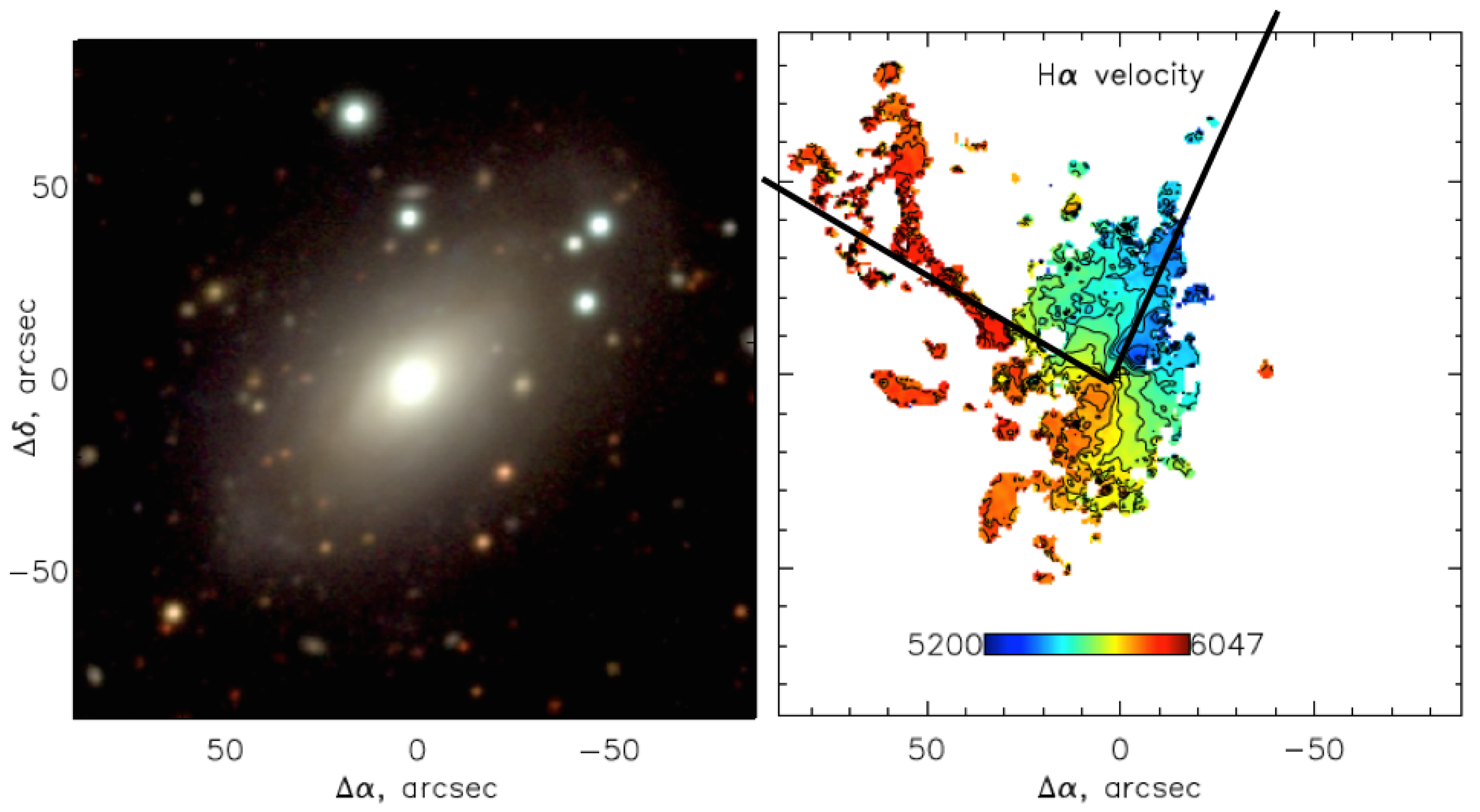
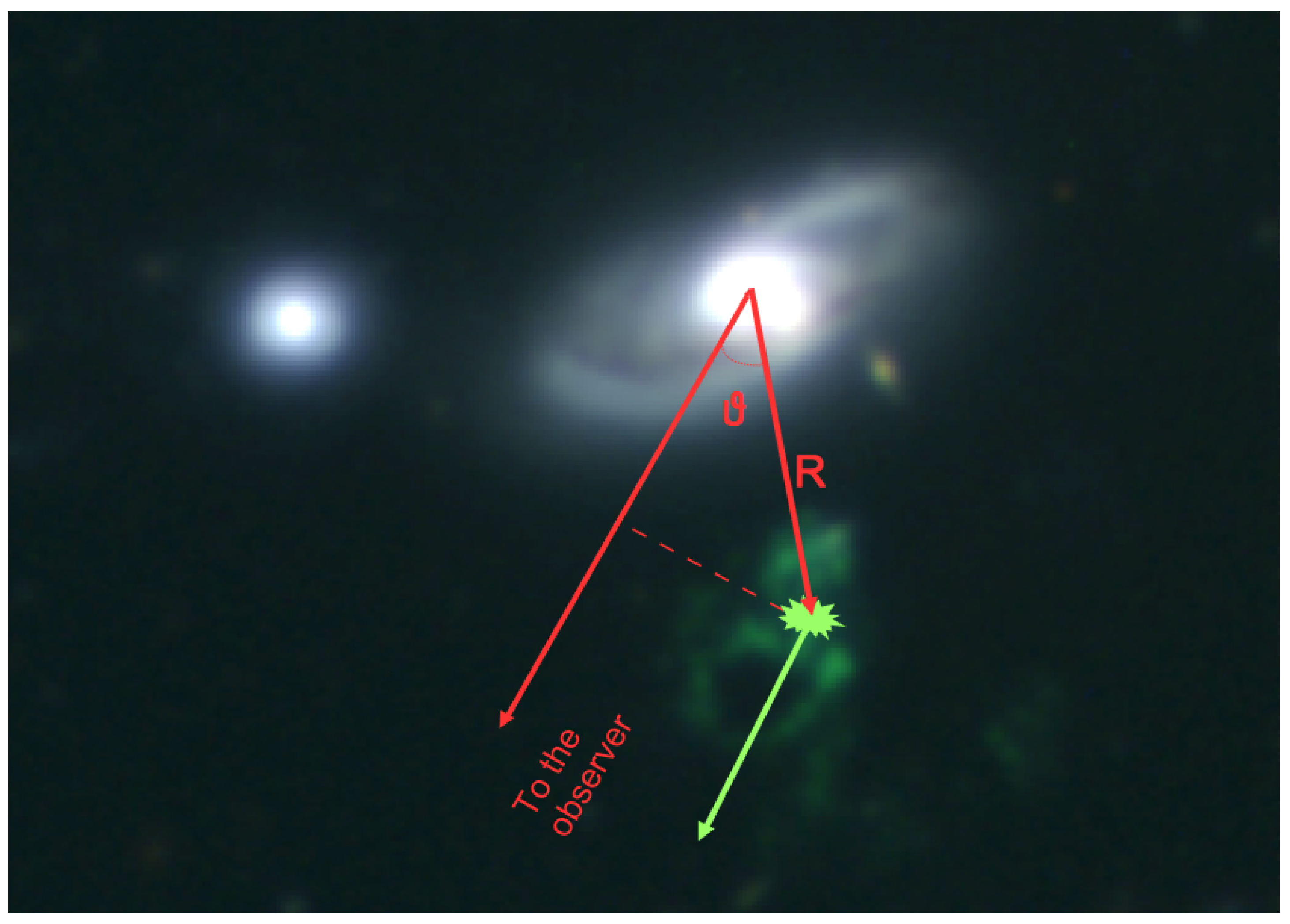
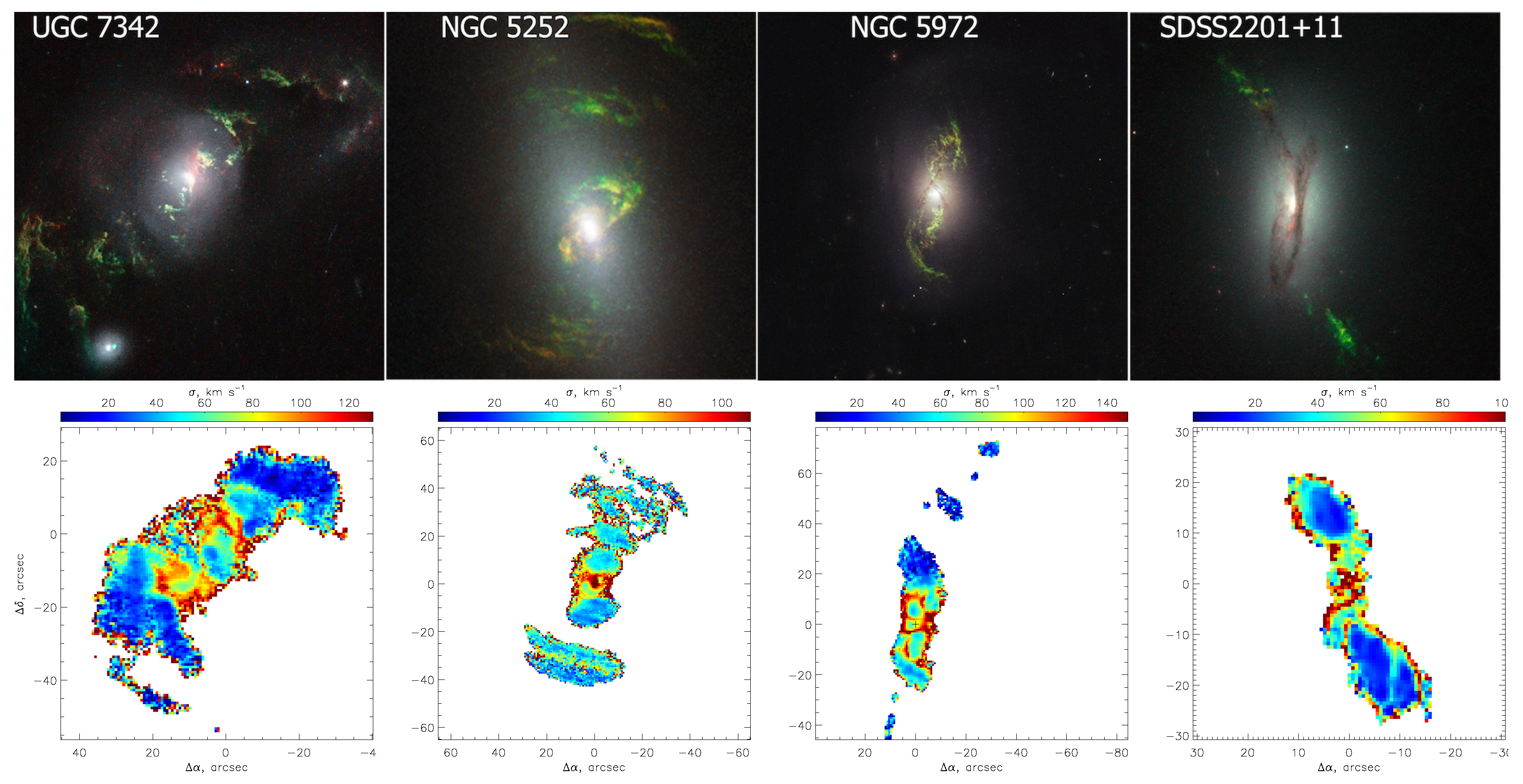

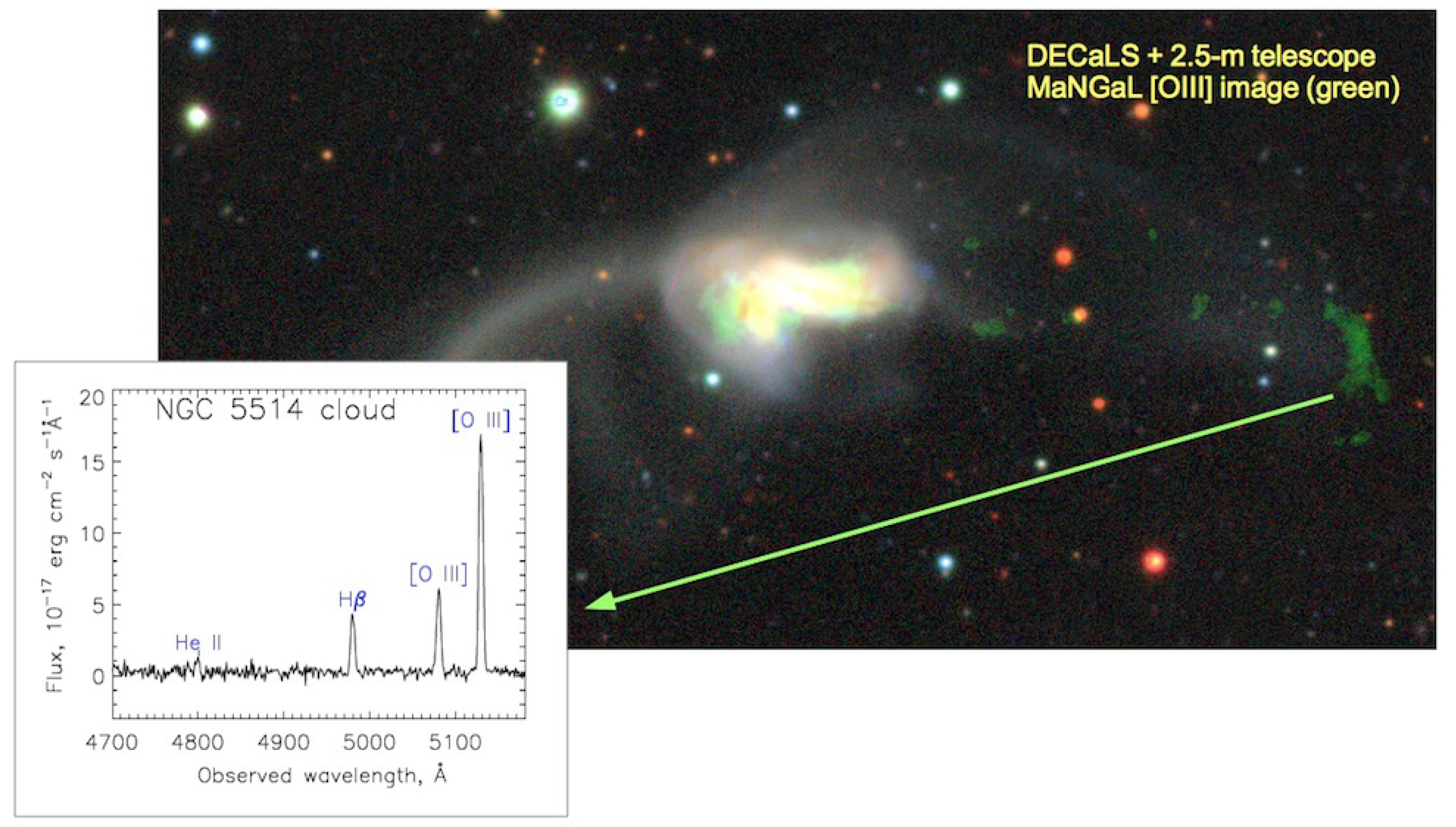
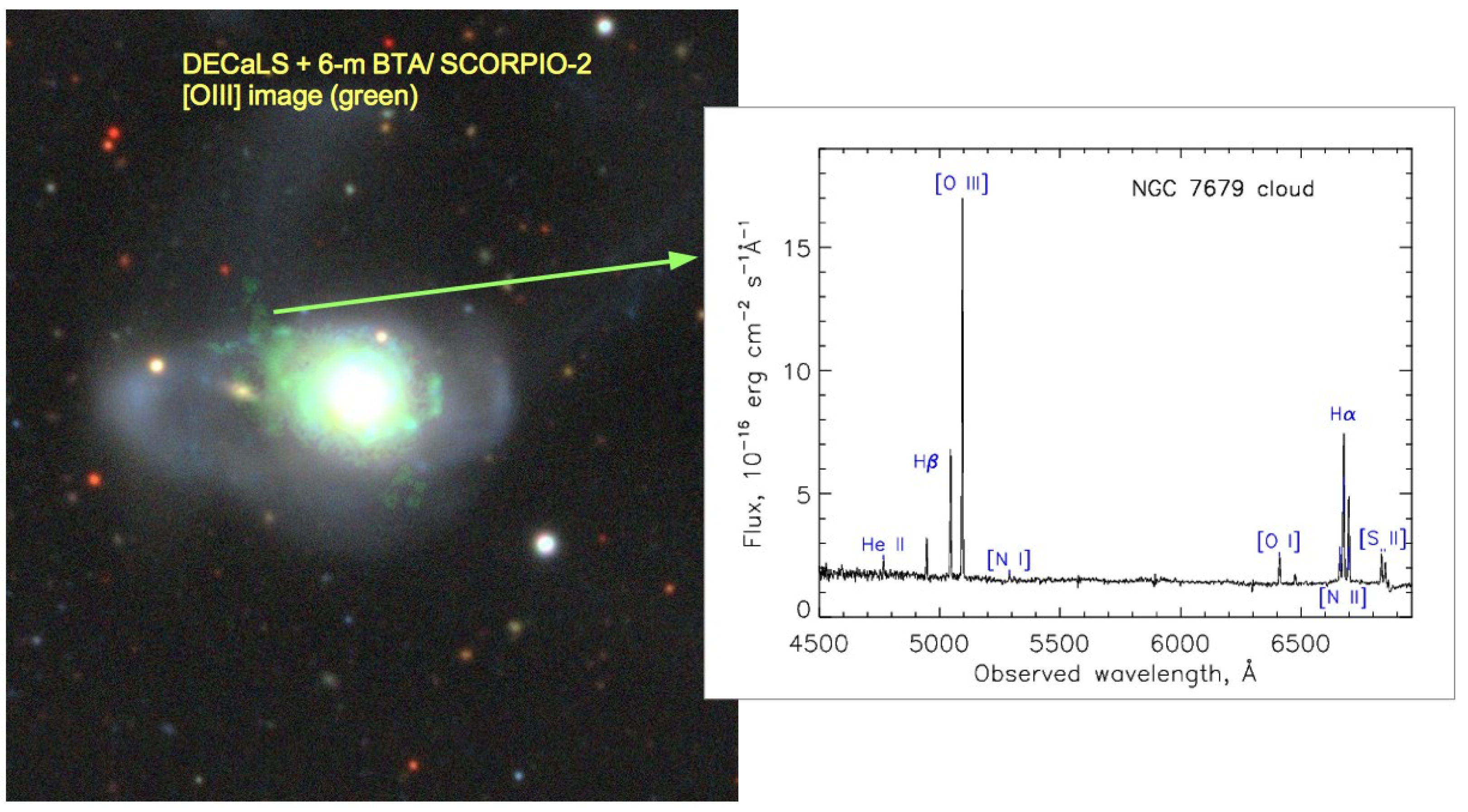

Disclaimer/Publisher’s Note: The statements, opinions and data contained in all publications are solely those of the individual author(s) and contributor(s) and not of MDPI and/or the editor(s). MDPI and/or the editor(s) disclaim responsibility for any injury to people or property resulting from any ideas, methods, instructions or products referred to in the content. |
© 2023 by the authors. Licensee MDPI, Basel, Switzerland. This article is an open access article distributed under the terms and conditions of the Creative Commons Attribution (CC BY) license (https://creativecommons.org/licenses/by/4.0/).
Share and Cite
Moiseev, A.V.; Smirnova, A.A. Ionizing Spotlight of Active Galactic Nucleus. Galaxies 2023, 11, 118. https://doi.org/10.3390/galaxies11060118
Moiseev AV, Smirnova AA. Ionizing Spotlight of Active Galactic Nucleus. Galaxies. 2023; 11(6):118. https://doi.org/10.3390/galaxies11060118
Chicago/Turabian StyleMoiseev, Alexei V., and Aleksandrina A. Smirnova. 2023. "Ionizing Spotlight of Active Galactic Nucleus" Galaxies 11, no. 6: 118. https://doi.org/10.3390/galaxies11060118
APA StyleMoiseev, A. V., & Smirnova, A. A. (2023). Ionizing Spotlight of Active Galactic Nucleus. Galaxies, 11(6), 118. https://doi.org/10.3390/galaxies11060118







